
Today, the upper block of Church Street in Burlington, Vermont is a bustling center of commerce. As the city has grown, the Church Street area has evolved to meet the needs of an expanding population and burgeoning tourism. It is used today as an avenue for shopping and local festivals celebrating art and culture of the city and state. The history of this street, part of which is listed on the National Register of Historic Places, reveals stories about larger changes in American culture in the last two centuries.1 Primarily, one can see the transition from a rural town to a bustling city, the impact of the rise of industry in the mid- and late-1800s, and the growth of commercial enterprises throughout the twentieth century. The block’s ever-changing landscape and use are evidence of these changes and the evolving needs of the city’s proprietors and citizens. To better understand the historical themes that shaped the appearance and character of Church Street and Burlington, we can trace the history the area along one city block.
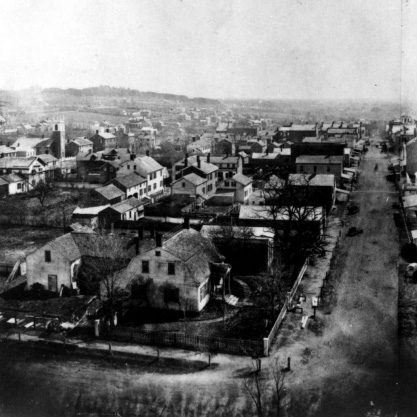
The upper block of Church Street between Cherry Street and South Winooski Avenue (formerly White Street) was a residential area that grew in population as a result of commercial expansion in Burlington and Winooski. The earliest map of the area is the 1830 Young Map, which displays Burlington Village as it was then known. It shows five buildings in this stretch, but no businesses or proprietor names are included.2 A picture from 1860 shows some of the wooden houses facing Church and Cherry Streets (Figure 2). By 1877, maps show upper Church Street and Cherry Street as a series of tightly packed buildings and open spaces in the center of the block, which can also be seen in the picture above.3 It is evident from Sanborn maps that the area grew in the number of buildings by the end of the nineteenth century. City maps and directories record the names of many of the owners and residents of the upper block, which were constantly changing. The buildings along this road were growing larger, and were changing to accommodate businesses as well as residences.
By the latter half of the nineteenth century, there was an increase in manufacturing at Winooski Falls and commerce in Burlington as a result of the construction of new railroads and the Champlain Canal in 1819 and Chambly Canal in 1843. This growth led to the connection of Burlington and Winooski through Winooski Avenue, which ran from the corner of Pearl Street and would later become North Winooski Avenue.4 Church Street and its blocks became a hub of business and commerce as new businesses slowly replaced residences or residents served customers in their homes. It slowly became a mainly commercial area of town, where some businesses would remain for decades along the street while others would be replaced within a few years. In late 1981 the Church Street Marketplace was officially opened as a pedestrian shopping mall by the city. In the 1990s and early 2000s, the top block was paved with brick and closed to traffic.5 Today, the street is home to some long-lasting businesses, but it also still sees turnover and movement of businesses on a regular basis, a trend that has characterized the area. The struggle for small business stability and longevity is evident throughout the history of the block.
Corner of Church Street
The building at the corner of Church and Cherry Streets, which is now listed as 34 (upstairs) and 36 (downstairs) Church Street, has been home to numerous local businesses, including several that have lasted for decades. The site seems to have served as an anchor for the upper Church Street block, and the popularity of the local businesses that thrived here is evident in their longevity. Many of these businesses represent the important impact of local businesses on the daily lives of the people of Burlington; they are staples in everyday life in Burlington. It is a prime location for shopping as the property is facing the center of the street and is easily accessible from almost any direction, and it remains a popular corner today.
The earliest map of the area from 1830 shows a building footprint at this corner.6 The building is generally in the same location as the building in the 1869 Sanborn map, which also contains the earliest recorded business at this location as a saloon.7 The 1862 Wainwright map shows the name Ishams at this corner.8 By the 1880s, the site was home to a hairdresser and, immediately afterward, a barber shop. The barber shop was owned by Patrick McMahon and a succession of other owners throughout the 1890s and 1900s, some of whom were former employees of McMahon.9 The barbershop at this corner represents one of the earliest long-standing businesses on Church Street. Though it had many owners, the business endured here until around 1908, when the site became Howard and Chase Meat Market. The name was changed to Howard’s Meat Market the following year when Chase retired, and it known by various names throughout its life, including the Howard Sausage Company.10 Similar in popularity to the barbershop, this business remained at the corner until 1933, when it moved to Battery and King Streets.11
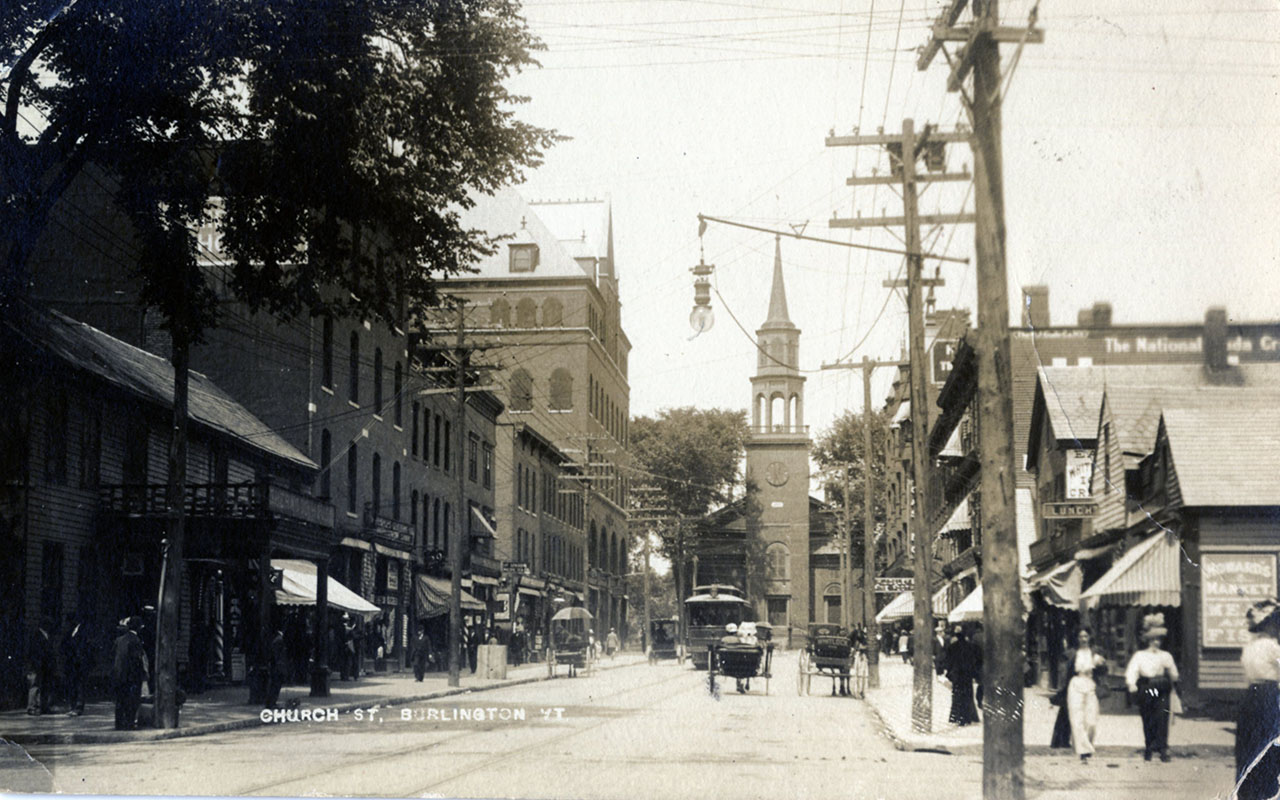
According to city records, the 34-36 Church Street building itself was constructed in 1899, but this is questionable because Sanborn maps from the early 1900s show a wooden framed building at this corner and the building currently at the corner is brick.12 A real photo postcard of the street corner taken between 1908 and 1912 shows a wooden, gable-front building with a striped awning and large sign for its proprietor (Howard’s Market) on the side at this corner, which is quite different from the building standing there today (Figure 3).13 The wooden building did survive several small fires in 1929 and 1935, which were put out with minimal damage, but it was soon replaced to make room for the current structure.14
In 1937, the new building for Liggett’s Drug Store was finished at the corner of the block, representing the first change in the building’s footprint and materials since the first Sanborn map in 1869.15 The building still stands today and is a two-story, rectangular brick block and the home of the current Ben & Jerry’s store. A postcard from 1941 shows the building as a white, brick two-story, indicating that is may have been painted when it was first built.16 Several fires did occur on adjacent blocks, such as ones that swept through the block of Church Street on the south side of Cherry Street in 1940, which caused the Liggett’s Drug Store at 36 Church Street to close for a time, but the Liggett’s store lasted until 1977, and the building itself has survived for eighty years.17 After Liggett’s closed, the building was then used for studios of various names for the next two decades.18
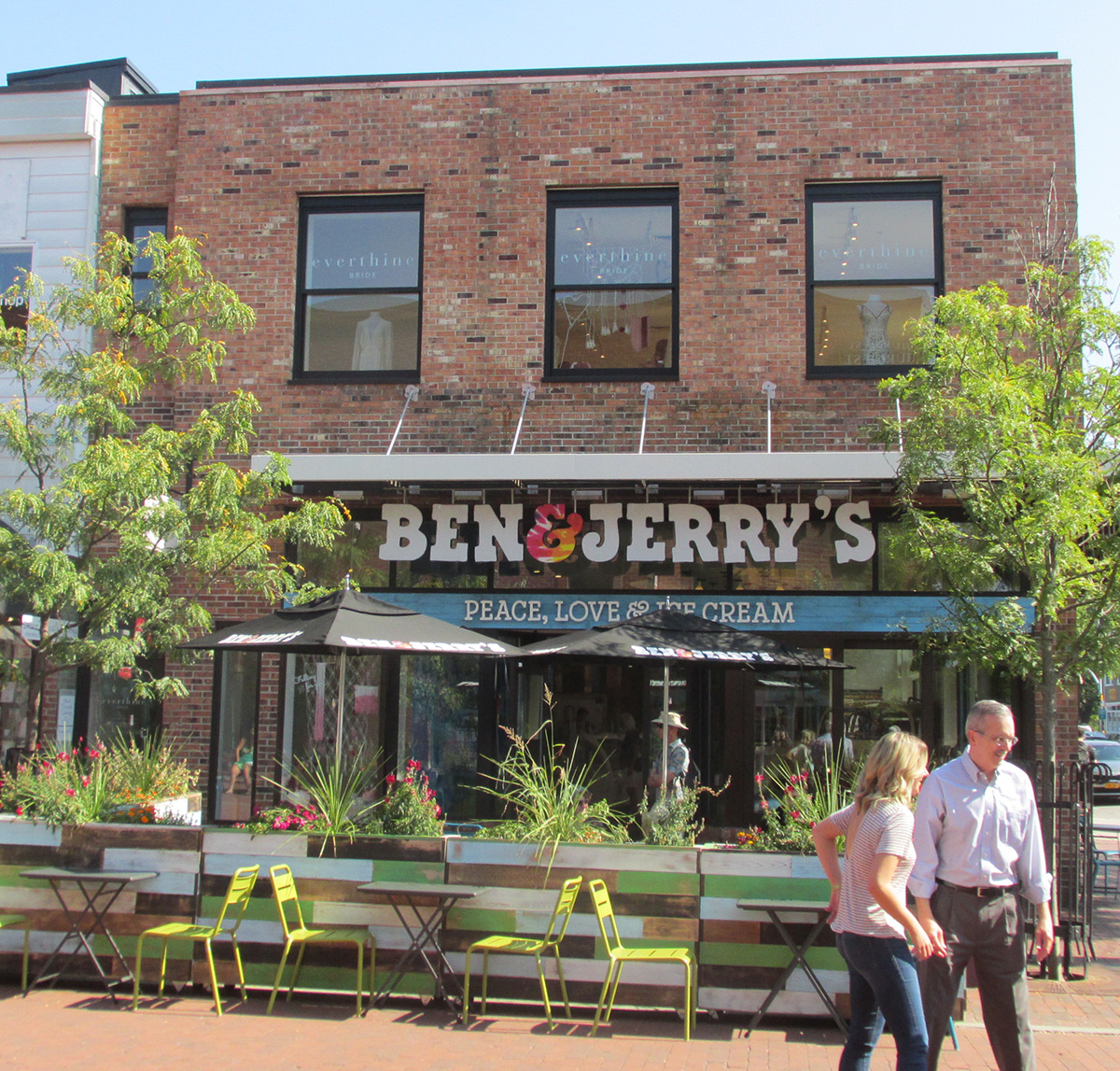
Today, 36 Church Street can be seen in its natural brick color (Figure 4). In 2016 Everthine Bridal Boutique moved into the second story of the building, but the corner is almost universally known in Burlington as the home of Ben & Jerry’s Ice Cream.19 The popular chain, which began in Burlington in 1978, opened its first store on Church Street in 1982. Today, the flagship location at 36 Church Street is a staple for locals, as well as a popular tourist attraction. The store was actually forced to move to the corner from their previous location at 123 Church Street when the former building was sold in 1996 for development. At that time, a company spokesman celebrated the opportunity to gain more street traffic at the new location and to serve as an anchor for the top block.20 Longstanding businesses that serve as community anchors is a tradition throughout the history of Church Street and in its adjacent blocks. It seems fitting that Ben & Jerry’s, a local Vermont business, should contribute to that trend with their location on the main tourist avenue in Burlington.
The movement of the business due to development is part of a larger trend that has occurred along Church Street in the latter half of the twentieth century, and which is also evident in small town centers throughout the country. As large business developments move into the surrounding areas, smaller businesses close or are forced out of their locations. This damages local downtown center economically and culturally as it is difficult for local businesses to compete with large corporations. Church Street has been somewhat successful in keeping small businesses, including retail shops, art galleries, and local restaurants, along its main corridor, but the presence of large business can be felt in the form of places like CVS, JC Penney, and Sears throughout the twentieth century.
In 1976, a large mall was opened in the center of the street as an urban renewal project. It was home to only smaller businesses when it first opened its doors, but it struggled to attract large department stores and was plagued by high turnover rates only a few years after opening.21 A new department store, Filene’s, was built behind the mall in an expansion of the retail area in 1999 and was meant to serve as an anchor to bring in new clientele and make the mall, and Church Street Marketplace, more competitive with other shopping complexes in Burlington suburbs, such as the University Mall.22 The department store was bought out and replaced by Macy’s in 2006, which remains as an anchor in the mall today.23 Despite this move, the mall itself is still remains mostly empty and new plans for a larger development are circulating in the city. Big business development is not confined to Church Street: it can be seen throughout the downtown blocks, including on adjacent streets, where one can find chain restaurants and corporate stores like Rite Aid.
Cherry Street
Cherry Street is one such place where development and small businesses can be seen together in the same small area. The block of Cherry Street between Church and White Street has changed drastically from the first city maps. In the mid-1800s the street was lined with residences, which were recorded in early Sanborn Fire Insurance maps. The center of the block was largely open, private property that included gardens and small structures, such as sheds or barns. While there has been some continuity in terms of long-lasting businesses and proprietors, the street has also seen many changes as a result of the growth of new industries.
The property lines from Cherry Street north to Pearl Street have shifted numerous times since they were first established, but the buildings have always been faced south onto the street. This stretch of Cherry slowly became an active commercial area, beginning in the late nineteenth century, and has been home to many local shops in the last century. It also exemplifies the struggle of small businesses that have had a difficult time surviving as they are bought out by or cannot compete with large corporations. Additionally, in this block lived some of the most influential Burlington citizens of their time, who served a physical and cultural anchors for the community. This street provides evidence of the transition of Burlington from a small town to the largest city in the state.
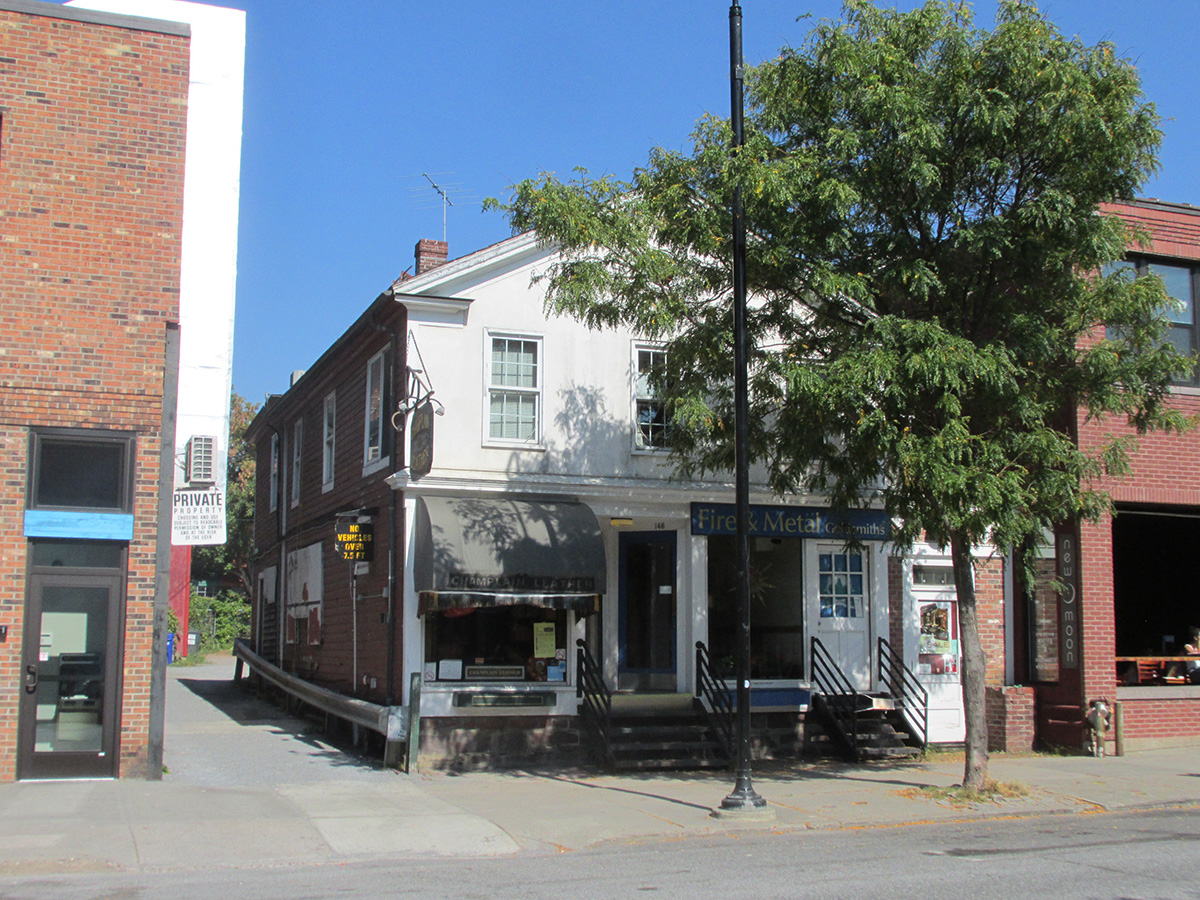
Various types of businesses line the Cherry Street block today. Directly east of Ben & Jerry’s building is a building that houses Champlain Leather (144 Cherry Street) and Fire and Metal Goldsmiths (146 Cherry Streets), which occupy the same building (Figure 5). The building is a front-gable, rectangular, two-story structure. According to city records, the current building at this site was built in 1899, a change which is consistent with the new building footprint in the 1900 Sanborn map.25 It has withstood many changes in ownership by businesses and boarders, and even a small fire in 1908 and a fire that was part of a rash of arsons in Burlington in 1998.26 Champlain Leather was established in 1975 and has occupied 144 Cherry Street since at least 1979, making it another example of longstanding local businesses that give Church Street a uniquely Burlington character.27
One example of a cultural anchor on this street was Dr. Harvey Edmund Colvin, a prominent member of the Burlington citizenry in his day, who founded a medical practice at 150 Cherry Street in the 1884.28 A graduate of the Chicago Homeopathic Medical College, he specialized in medicine for women and children and he lived and worked on Cherry Street for over fifty years until around 1937 when he died.29 By 1903, he was the oldest practicing homeopathic doctor in the county.30 Other medical practices moved into the Cherry Street block in the 1890s and lasted for varying stretches, but Colvin’s had the greatest longevity. The property and its buildings were sold by Dr. Colvin’s widow in 1944.31
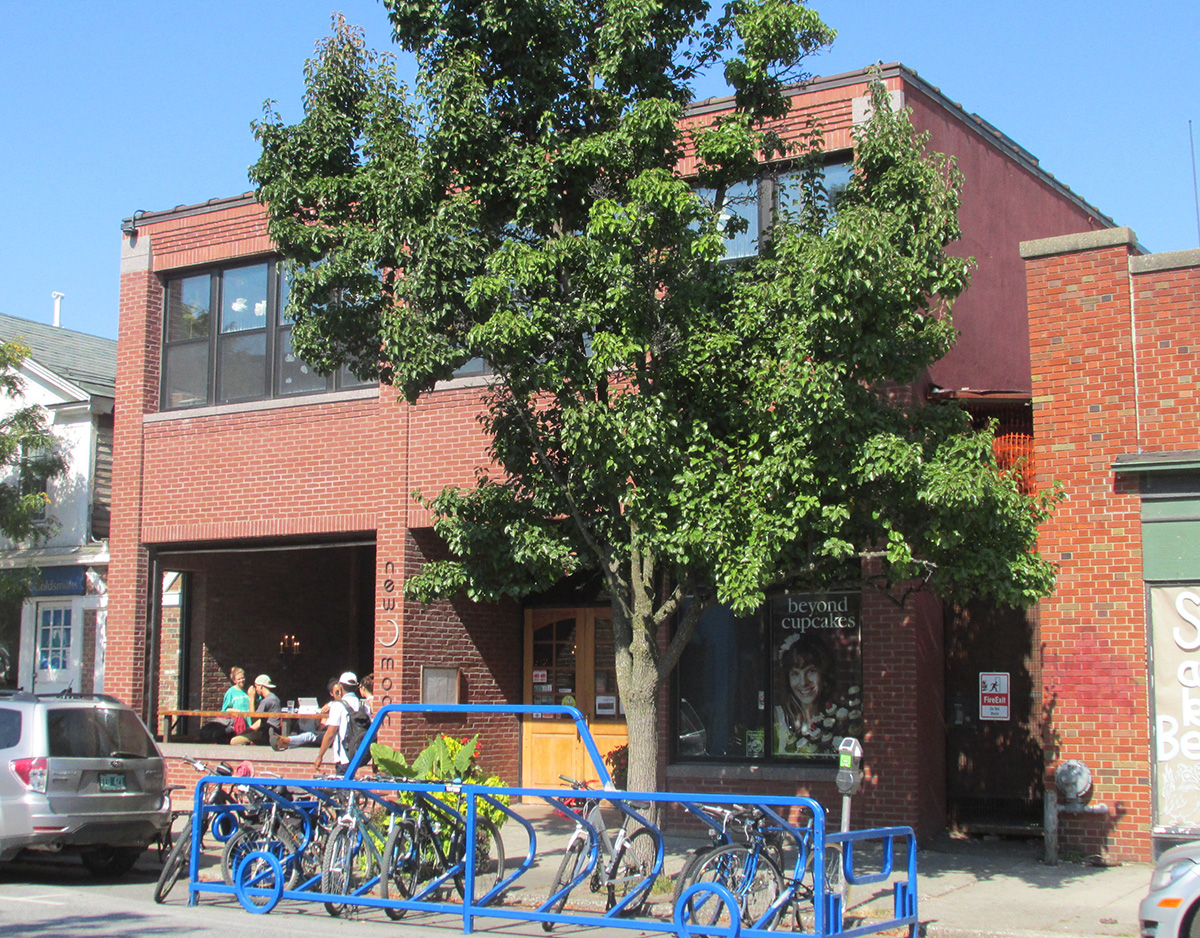
Today, the building at 150 Cherry Street is a two-story brick building constructed in 1945, and it has housed multiple businesses in the time since Dr. Colvin occupied the site (Figure 6).32 New Moon Café moved in to the building in 2007. At that time, the building housed the café, a large performance space in the back, and offices on the second floor.33 The space is much the same today and is a part of religious community group that focuses on working with at-risk populations.34
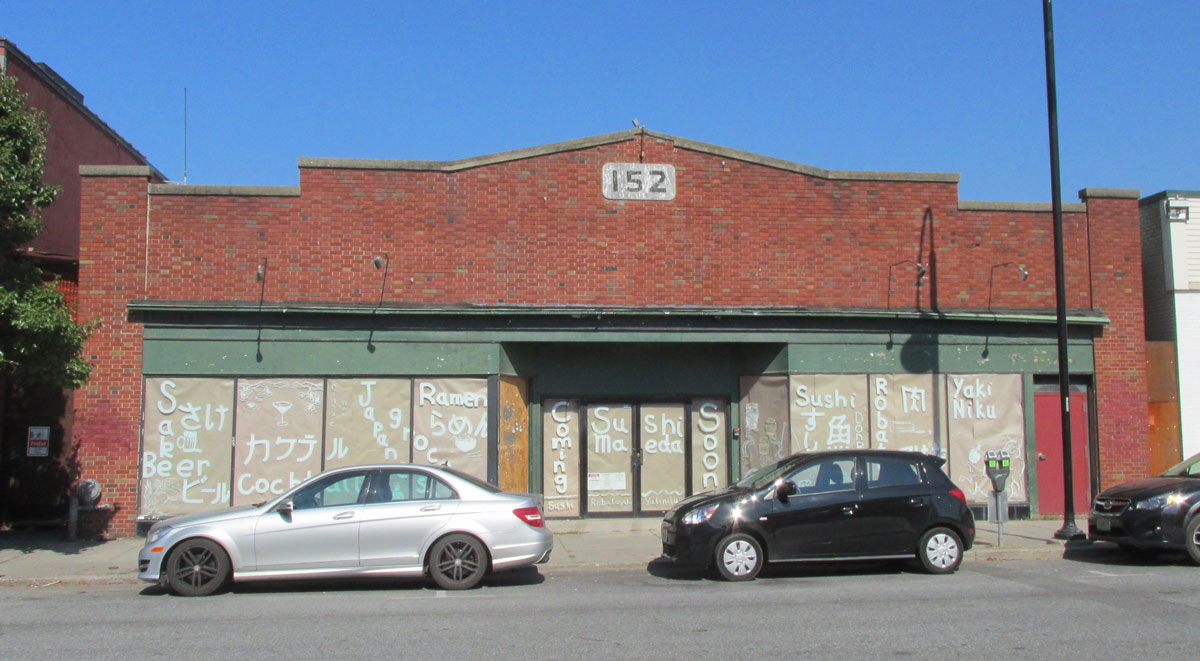
Currently, the building at 152-156 Cherry Street, sits empty, though it was recently home to Outdoor Gear Exchange. It is a wide, 1-story brick building with an almost full facade of windows. Signs on the building as of October 2017 advertise a new sushi restaurant will be moving into the space soon (Figure 7). The location had been the site of several residences in the 1800s at 152 and 154 Cherry Street, as seen in the bird’s eye view of the city in 1860 (above). Beginning in the 1890s, the building on these sites were home to families and boarders, including Dr. H.A. Crandall and his wife Fannie, who occupied the addresses at 152 and 154 with their home and medical office.35 By 1926, 152 Cherry Street had become Yandow Tire and Battery Company, a business which would evolve many times throughout the next few decades, and which was replaced with the current structure when the site was taken over.36 In 1940, the Yandow garage building was expanded for a new Grand Union Store, which also required a new parking lot the larger volume of customers.37 The building on the site today is representative of the change to the store front.
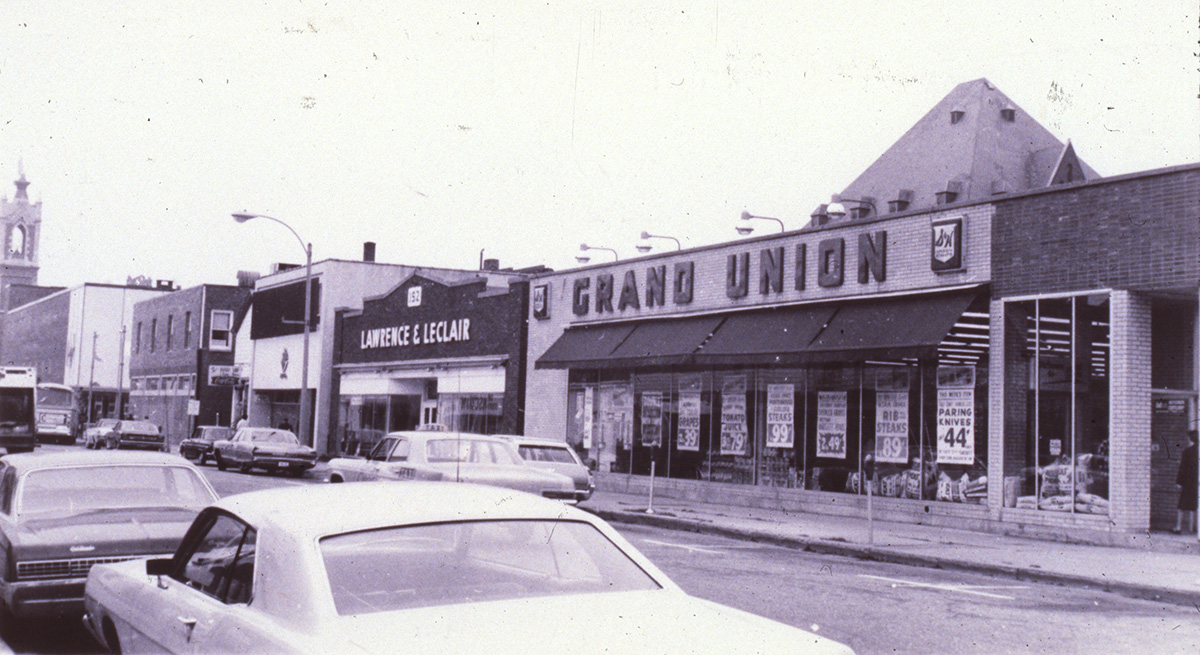
In 1953, the land was bought by Lawrence and LeClair furniture dealers, and when its lease ran out on the site in 1955, the Grand Union moved to a new building at the corner of Cherry Street and South Winooski Avenue (Figure 8).38 This corner used to be 164 Cherry Street and is 158 Cherry Street today. The store lasted until 1990, when it was bought by Price Chopper, and both stores were staples of the block and represented major resource for those living in downtown Burlington.39
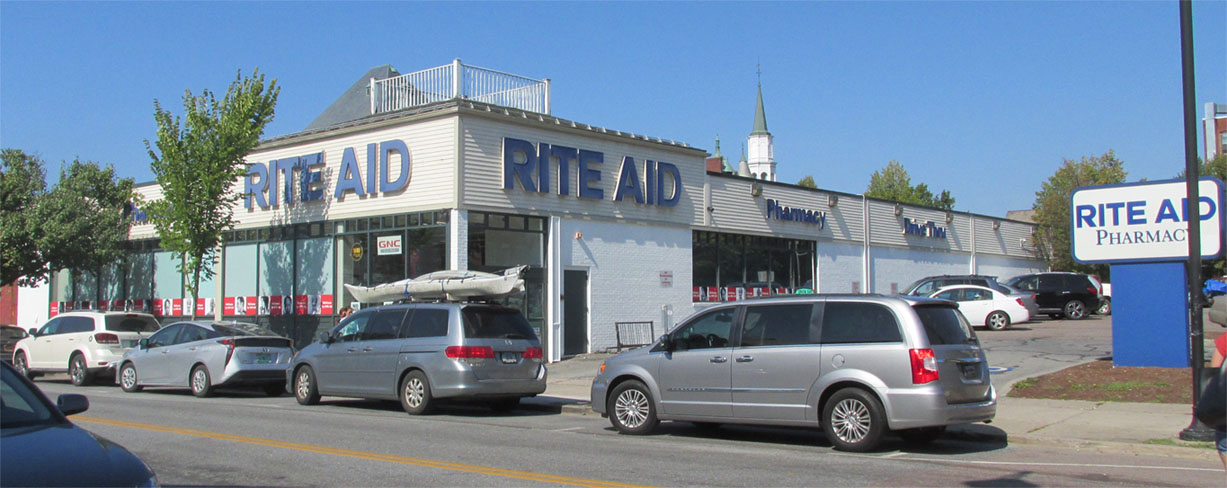
The former Price Chopper grocery store is a Rite Aid pharmacy today, and building is still surrounded by a large parking lot that stretches halfway up South Winooski Street toward Pearl Street (Figure 9). But this large structure was a drastic change for the site, which had been a residence for almost a century. A house can be seen on the site beginning in 1830 maps, and as early as 1862, this corner was home to Greene D. Weller and his family.40 An owner of multiple grocery stores throughout his life, he was a prominent member of the Burlington community in the late 1800s. He served in various capacities as a member of Burlington’s city government for twenty-seven years, including as city assessor, cemetery commissioner, and city treasurer, an office he occupied for twenty-one years.41 His steady presence on the Cherry Street corner for three decades seemed to serve as an anchor for the community and street, a symbol of the residential area that the block used to be.
Weller’s former house was one of the last residences to remain on this block of Cherry Street, but it succumbed to commercialization of the block by the mid-twentieth century. Soon after his death, Weller’s property seems to have been sold by his son after 1899 and it then became a home for many resident boarders and small businesses throughout the next few decades.42 The property included two buildings, with a larger one facing Cherry Street and a smaller one facing South Winooski Avenue, but all within the same address. In 1926, a home bakery was recorded on the site, and from then on the site was used for various residences, offices, and stores.43 It was taken over in 1955 by the Grand Union store when their new building was constructed.
There has been long history of physicians and surgeons who lived and worked on this block, including the practice of Dr. Colvin and Dr. Crandall. Perhaps fittingly, the corner of Cherry and South Winooski was a Brooks Pharmacy in 2006 when this company was bought out by the larger Rite Aid Corporation.44 The merger caused tensions when the big store ended the 24 hour availability of the store, which had made it the only pharmacy available in downtown Burlington with extended hours. Citizens were concerned that those without cars would find it difficult to get their medicines.45 The transition resulted in a loss accessibility and community feeling at the corner. The street corner seemed to lose some of its local character through the introduction of another chain store to the Church Street Marketplace area. Other small towns experiencing these types of transitions may have felt a similar sense of powerless to control the growth of commercialization in their downtown district. Cherry Street today remains a mixture of small businesses punctuated with larger companies today, so some of the Burlington character is retained, but it has lost much of its link to the residential history of the block.
White Street and South Winooski Avenue
South Winooski Avenue, which was formerly White Street, runs north to south between Pearl Street and Cherry Street along the outside of the upper Church Street block. According to historian David. J. Blow, in 1837 a new wool mill was built beside Winooski Falls and the next year a new road was built to avoid the Colchester Avenue hill. This road connected the mill to the docks at Burlington Bay and was named North Winooski Avenue. In 1873, White Street, which began at the Intersection of Pearl Street and North Winooski, was renamed South Winooski Avenue as a continuation of this road, and this change was reflected in city directories by 1875.46
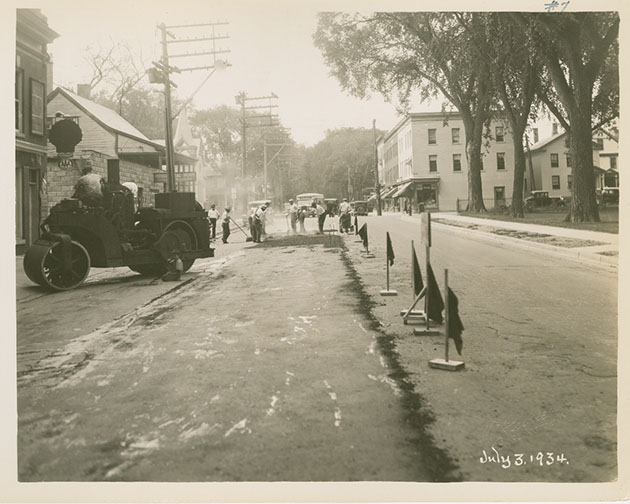
Residences are shown in early maps of White Street between Cherry and Pearl Streets. As on Cherry Street, this stretch moved toward commercial enterprises throughout the twentieth century. Today, more than half of the block is occupied by parking lots adjacent to Rite Aid and none of the previous buildings that housed longstanding businesses survive.Cherry Street and South Winooski Avenue were reflective of new industries that arose in the early 1900s in America, including the many technological expansions in transportation industries. In the 1890s, streetcar tracks were installed in Church Street to accommodate the new form of transportation (Figure 10). These were replaced by busses in the 1920s, around the same time that personal automobiles were becoming a part daily life in Burlington.47 From 1912 to the 1950s, several garages, auto parts shops, gas stations, and automobile dealers could be found on both Cherry and along South Winooski at the newly defined addresses of 11-15 South Winooski Avenue. These included those owned by the Yandow family for several decades—a family which still owns auto shops in Burlington today (Figure 11).48 There auto shops and dealers are additional examples of a how longstanding local business helped support and characterize Church Street and its surrounding areas. There is still a parking garage on the south side of the Cherry Street block, which recalls this history today.
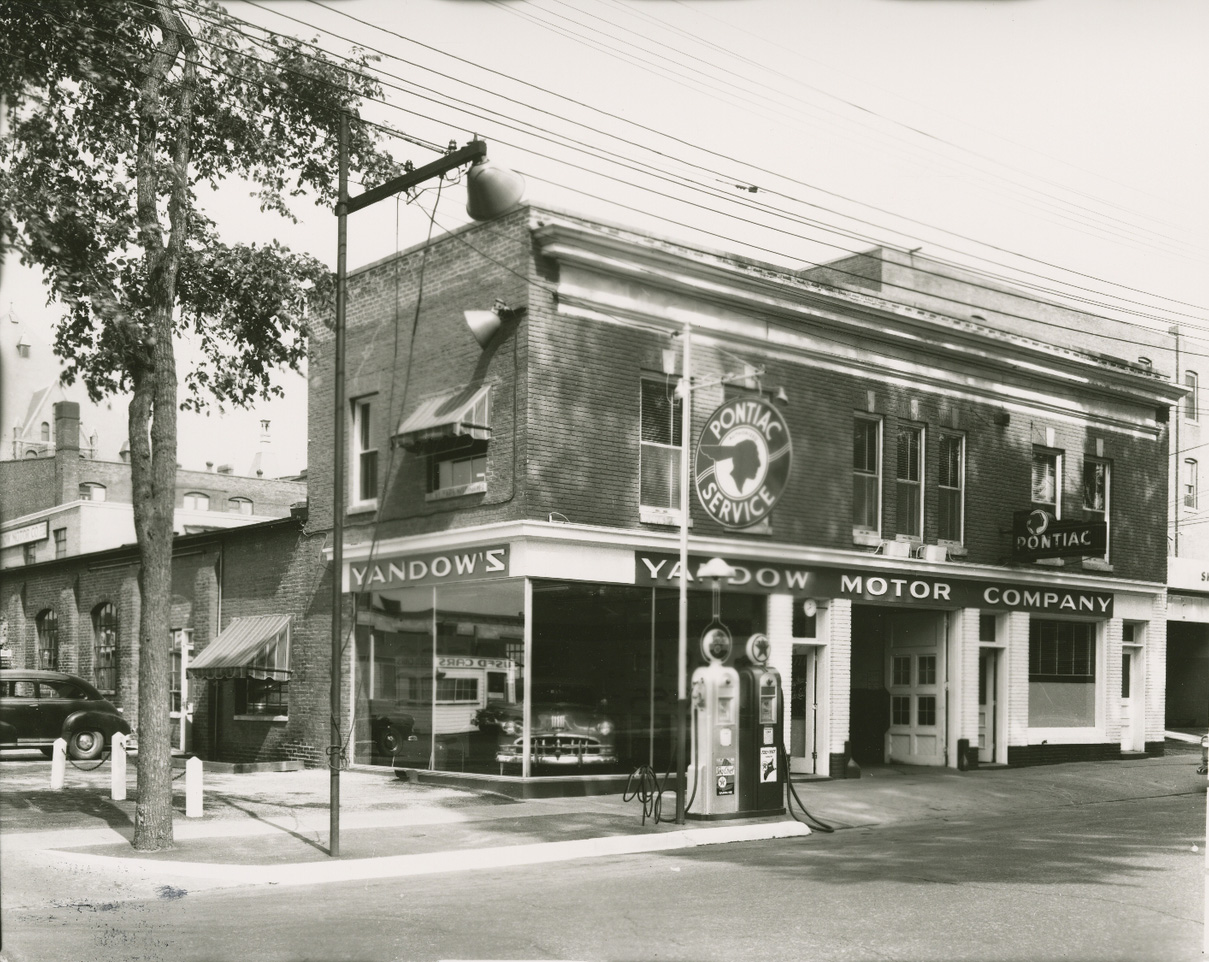
One can also see a transition in American building materials and technologies along this street. The buildings along the Cherry Street and White Street block are first described as wooden on the earliest nineteenth century Sanborn maps.49 In the late 1800s and early 1900s, brick and brick-veneered buildings appear throughout upper Church Street on these maps. By the 1920s there were steel frame and cement floored garages facing south from Cherry Street and facing east from South Winooski Avenue.50 As new buildings were built in the twentieth century, new materials were used, reflecting the evolution of building designs and technology in New England.
The upper Church Street block between Cherry Street and South Winooski Avenue has evolved from a residential neighborhood to an important commercial stretch in the heart of the city. Its history is demonstrative of many small towns in America that grew into large cities in the twentieth century. As result of this growth, it has experienced some of the struggles that other small towns have faced: local businesses being bought out by larger retailers; the need to create an attractive space for locals and visitors to shop; and the tension between accessibility, expansion, and the desire for quality. Today, it is still an area where citizens can express their feelings about these issues and other local issues. Recently, the Ben and Jerry’s ice cream parlor was the site of a protest against pesticides in organic foods.51 The protesters expressed a community desire to hold businesses accountable for the effects of their growth.
Such tensions between growth and character are evident in the current controversy about a new development to replace the nearly empty mall on Church Street. While architects argue that the design of the proposed Burlington City Center will integrate into the streetscape and will become a part of Church Street rather than stand above it, some are skeptical that it is not in keeping with the character of downtown.52 There has been a culture of local businesses in Burlington, and the upper Church Street block is demonstrative of this history. Upper Church Street has changed in countless ways since the area was settled as Burlington, and it will continue to reflect cultural changes in the city and nation as long as it remains the heart of downtown.
NOTES
1. National Register of Historic Places Nomination: Head of Church Street, Chittenden County, Vermont. Montpelier, Vermont: Agency of Development and Community Affairs, Historic Sites Division, 1973.
2. Ammi B. Young, Plan of Burlington Village. [map] Burlington, Vermont: 1830. Accessed October 19, 2017, Special Collections, University of Vermont Library, http://cdi.uvm.edu/collections/item/Burlington_Young_1830.
3. J. J. Stoner, Birds eye view of Burlington and Winooski VT. [map] Accessed October 19, 2017, Special Collections, University of Vermont Library, http://cdi.uvm.edu/collections/item/Burlington_Map-1877birdseye.
4. The Burlington Book: Architecture, History, Future (Burlington: University of Vermont Historic Preservation Program, 1980), 9.
5. “History,” Church Street Marketplace, Accessed October 19, 2017, http://www.churchstmarketplace.com/about/history.
6. Ammi B. Young, Plan of Burlington Village. [map] Burlington, Vermont: 1830. Accessed October 19, 2017, Special Collections, University of Vermont Library, http://cdi.uvm.edu/collections/item/Burlington_Young_1830.
7. Sanborn Map Company. Burlington 1869, Sheet 01. [map] New York: Sanborn Map Company, 1869. Accessed through Special Collections, University of Vermont Library, October 17, 2017, http://cdi.uvm.edu/collections/item/btvfi_1889_003.
8. C. Wainwright. The Village of Burlington, Vt. [map] Burlington, Vermont: 1862. Accessed November 3, 2017, Special Collections, University of Vermont Library, http://cdi.uvm.edu/collections/item/Burlington_FreePres
9. Burlington City Directory and Business Advertiser: July, 1879 to July, 1881 (Burlington: The Free Press Association, 1879), 70. Sanborn Map Company. Burlington 1906, Sheet 17. [map] New York: Sanborn Map Company, 1906. Accessed October 19, 2017, Special Collections, University of Vermont Library, http://cdi.uvm.edu/collections/item/btvfi_1906_017.
10. Burlington City and Winooski Directory for 1908 (Burlington: L.P. Waite & Co., Publishers, 1908), 160. Burlington City and Winooski Directory for 1909 (Burlington: L.P. Waite & Co., Publishers, 1909), 168.
11. “Howard Sausage Company Moving Into New Plant,” Burlington Free Press, March 23, 1933.
12. “Property Database,” Burlington City Government, accessed October 22, 2017, https://property.burlingtonvt.gov/PropertyDetails.aspx?a=5317. Sanborn Map Company. Burlington 1900, Sheet 17. [map] New York: Sanborn Map Company, 1900. Accessed October 19, 2017, Special Collections, University of Vermont Library, http://cdi.uvm.edu/collections/item/btvfi_1900_017.
13. “Church St., Burlington, VT.” Vermont Postcard Collection, Special Collections, University of Vermont Library.
14. “Early Morning Fire,” Burlington Free Press, May 7, 1935. “Nine Business Concerns Seeking New Locations,” Burlington Free Press, May 2, 1929.
15. “Work on New Structure at Church and Cherry Streets to Begin at Once,” Burlington Free Press, July 17, 1937.
16. 2010.1.1162. Llewellyn Collection of Vermont History, Special Collections, Champlain College. Accessed October 17, 2017 http://specialcollections.champlain.edu/digital-collections/index.php/Detail/Object/Show/object_id/1864
17. “Fire Forces Some 20 Establishments to Halt Business,” Burlington Free Press and Times, February 15, 1940. Manning’s Burlington and South Burlington, Essex Junction, and Winooski Directory 1977, (Bellows Falls: H.A. Manning Company, 1977, 398.
18. 1992 Catalyst Business and Household Digest of Burlington, U.S. Marketing Resources Group, Inc., 1991, 577.
19. “Property Activity Summary Report: 34-36 Church Street,” Burlington City Government, accessed October 12, 2017, https://www2.burlingtonvt.gov/CrystalReport/?k1=e206b566-2643-4c21-be0c-fd4855b7fe02&k2=e178dac7-e818-49ee-ac40-4d6e98fb441c&f=pdf&d=20&r=B1A267F1-1989-46A2-B3A5-0156F704E9F6&p1=044-4-018-000.
20. Stacey Chase, “Shops planned for Merchants building,” Burlington Free Press, May 11, 1996.
21. “Shops Opening in Burlington’s Underground Mall,” Burlington Free Press, November 1, 1976. McKay, Scott. “Pedestrian Mall Attracts People to Church Street,” Burlington Free Press, October 17, 1982.
22. Soga, Aki. “Filene’s Arrives with great hopes,” Burlington Free Press, November 14, 1999.
23. McLean, Dan. “Burlington Filene’s store will switch over this fall,” Burlington Free Press, July 5, 2006.
24. Sanborn Map Company. Burlington 1869, Sheet 01. [map] New York: Sanborn Map Company, 1869. Accessed October 17, 2017, Special Collections, University of Vermont Library, http://cdi.uvm.edu/collections/item/btvfi_1869_001.
25. “Property Database,” Burlington City Government, accessed October 22, 2017, https://property.burlingtonvt.gov/PropertyDetails.aspx?a=5334. Sanborn Map Company. Burlington, 1900, Sheets 17. [map] New York: Sanborn Map Company. Special Collections, University of Vermont Library.
26. “Fire on Cherry Street,” Burlington Weekly Free Press, May 14, 1908. “Fire Damages Cherry Street Store,” Burlington Free Press, January 4, 1998.
27. Champlain Leather, Advertisement, December 31, 1979, Burlington Free Press.
28. Burlington City Directory: 1884-5 (Burlington: Free Press Association, 1884), 190.
29. “Card of Thanks,” Burlington Free Press, January 14, 1937.
30. Hiram Carleton, Genealogical and Family History of the State of Vermont, (New York: The Lewis Publishing Company, 1903), 266.
31. “Buy Cherry St. Property,” Burlington Free Press, August 1, 1944.
32. “Property Database,” Burlington City Government, accessed October 22, 2017, https://property.burlingtonvt.gov/PropertyDetails.aspx?a=5335.
33. Dan McLean, “New Moon pioneers new design,” Burlington Free Press, August 26, 2007.
34. 150 Cherry Street. Accessed October 22, 2017, http://www.150cherryst.org/.
35. Burlington City Directory for 1894 (Burlington: L.P. Waite & Co., Publishers), 109.
36. Burlington and Winooski (Vermont) Directory for the Year Beginning July 1926 (Springfield, MA: H.A. Manning Company), 368.
37. “Grand Union Here Today Opens Its Largest Vermont Store,” Burlington Free Press, July 11, 1940.
38. “Lawrence and LeClair Buy Grand Union Market Building from Harry A. Yandow,” Burlington Free Press, October 31, 1953. “Grand Union Will Have New Store On Cherry Street,” Burlington Free Press, February 1, 1955.
39. Ted Tedford, “N.Y. Price Chopper chain to buy 12 Vt. food stores,” Burlington Free Press, February 6, 1990.
40. C. Wainwright. The Village of Burlington, Vt. [map] Scale not given. Accessed October 19, 2017, Special Collections, University of Vermont Library, http://cdi.uvm.edu/collections/item/Burlington_FreePress.
41. “Death of G.D. Weller,” Burlington Free Press, December 26, 1895.
42. Burlington City Directory for 1899 (Burlington: L.P. Waite & Co., Publishers, 1899), 249.
43. Sanborn Map Company. Burlington, 1926, Sheets 5 and 6. [map] New York: Sanborn Map Company. Special Collections, University of Vermont Library.
44. Marc Levy, “Rite Aid to by Brooks, Ecker drugstores,” Burlington Free Press, August 25, 2006.
45. Dan McLean, “Drugstore might cease daily 24-hour schedule,” Burlington Free Press, August 27, 2007.
46. David, J. Blow, Historic Guide to Burlington Neighborhoods (Burlington: Chittenden County Historical Society, 1990), 47. Burlington City Directory and Business Advertiser: July 1875 to July 1876 (Burlington: Free Press Association, 1875).
47. Erica Donnis, “Church Street: The Hearts & Soul of the Queen City,” Burlington Free Press, April 30, 2017.
48. Manning’s Burlington Winooski South Burlington and Essex Junction (Vermont) Directory: For Year Beginning January, 1954 (Springfield, MA: H.A. Manning Company, 1954), 336. “Palace Garage Sold to F.A. Baillargeon and Leased to Yandow Co.,” Burlington Free Press, February 17, 1930.
49. Sanborn Map Company. Burlington 1885, Sheet 03. [map] New York: Sanborn Map Company. Accessed through Special Collections, University of Vermont Library, October 17, 2017, http://cdi.uvm.edu/collections/item/btvfi_1885_003.
50. Sanborn Map Company. Burlington, 1926, Sheets 5 and 6. [map] New York: Sanborn Map Company. Special Collections, University of Vermont Library.
51. Abbey Gingras, “Protestors at Ben & Jerry’s voice concerns about herbicides,” Burlington Free Press, August 10, 2017.
52. Baird, Joel Banner. “Demolition at Burlington Town Center to begin in November,” Burlington Free Press, October 17, 2017.
